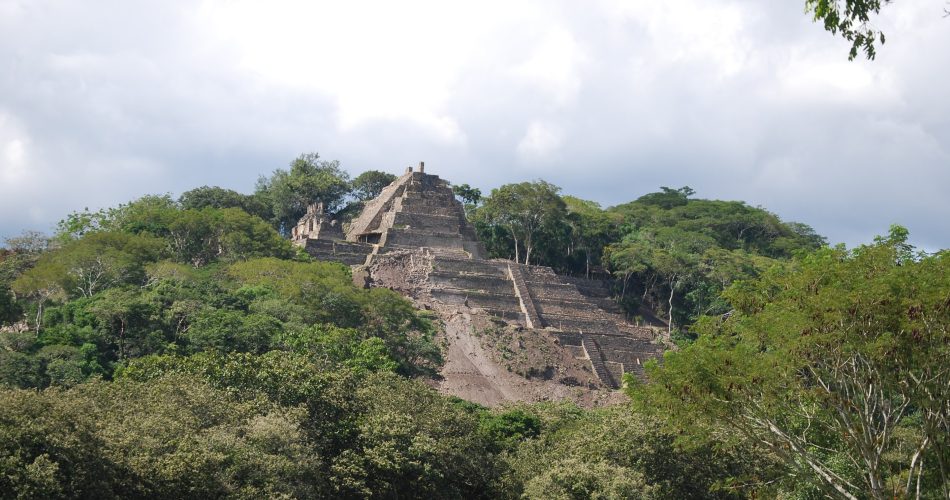Deep in the lush Chiapas region of Mexico lies Toniná, another stunning ancient Mayan city that’s often overlooked. Although perhaps not as famous as Chichén Itzá or Tikal, the city is home to one of the tallest and most unique pyramids in Mesoamerica, showcasing an incredible mix of culture, power, and architectural brilliance.
Toniná, meaning “House of Stone” in the Tzeltal Mayan language, thrived between 600 and 900 AD. Located in the Ocosingo Valley, Toniná rose up the hillside, making the most of its natural terrain. The city wasn’t just any Mayan settlement—it was a major power player, a rival to the city of Palenque, known for its military strength and monumental artistry.
The city’s history is literally written in stone. Carvings throughout Toniná tell tales of warfare, conquest, and power. But Toniná wasn’t only about battles. It was also a cultural hub, where rituals and ceremonies played out in its plazas and temples, reflecting the grandeur of Mayan beliefs and traditions.
The Massive Pyramid of Toniná: More Than Meets the Eye
The centerpiece of Toniná is its massive pyramid complex—one of the tallest built by the ancient Maya, even surpassing Palenque’s Temple of the Inscriptions. At 74 meters (243 feet) tall, it is actually taller than the Pyramid of the Sun at Teotihuacan. Unlike typical pyramids, Toniná’s pyramid isn’t just one structure. It’s an entire complex of seven terraces stacked on top of each other, forming a colossal acropolis. Each level is filled with temples, palaces, and ceremonial spaces, making it a giant maze of history and culture.
The complexity of Toniná’s pyramid tells us a lot about the ingenuity of its builders. It wasn’t just about size. I believe it was about creating a space for rituals, politics, and power. More importantly, from the top, you can look out over the Ocosingo Valley, a sight that once symbolized the city’s dominance.
Toniná hasn’t received the same spotlight as places like Chichén Itzá, and that’s partly because it’s not as easy to reach. But those who make the journey are rewarded with a site that feels untouched and authentic. Archaeologists have worked tirelessly to bring Toniná’s story to light, uncovering altars, stelae, and intricate carvings that depict the city’s rulers and their achievements.
Discovering the Stories of Toniná
One of the most remarkable discoveries at Toniná is the “Monument of the Prisoners,” an evocative stone carving depicting captured warriors. It offers a window into Toniná’s complex ceremonial and spiritual life. It’s the kind of find that helps us understand the dual nature of the Maya: warriors on one hand, deeply spiritual people on the other. It’s fascinating to see how these two worlds intertwined, and the art they left behind tells a vivid story of how Toniná’s leaders saw themselves.
But there’s more to Toniná than its carvings. The whole layout of the city hints at the Maya’s impressive understanding of astronomy. Structures were aligned to mark significant celestial events, suggesting that the entire city may have been an astronomical observatory of sorts. The pyramid itself, with its various terraces, likely served as a platform for stargazing and tracking the movements of the heavens.
The pyramid at Toniná was more than just an impressive structure. For the Maya, these pyramids were sacred pathways that connected the physical world with the heavens above. Each level of Toniná’s pyramid brought them one step closer to the divine, embodying their layered view of the cosmos. Climbing these terraces wasn’t merely an act of ascending stone steps; it was a symbolic journey, a ritualistic path toward a closer connection with their gods.
The construction process was nothing short of monumental. Thousands of workers were armed with only primitive stone tools, painstakingly carving and moving massive limestone blocks. The work was exhausting, and it showed the incredible determination and coordination of the people of Toniná. The scale of the project demonstrates not just engineering skill but also the social power of Toniná’s rulers, who could rally such a workforce for this grand project. The pyramid was both a spiritual center and a statement of authority—something that told everyone, near and far, about the might and influence of this city.
Experiencing Toniná Today
Visiting Toniná is like stepping into a time capsule, but that is something I tend to always say when I talk about similar ancient sites. For me, it feels just like that.
Unlike the ruins of Chichén Itzá, Toniná offers a quiet and personal journey into the past. There are no crowds, no rush—just the ancient stones, and the echoes of history. The terraces reveal stories as you walk through them, and the on-site museum adds even more depth. Here, you’ll find well-preserved artifacts—pottery, carvings, and everyday tools—that give you a glimpse of what life was like in Toniná. Without the distractions of commercialization, the experience feels raw and genuine, almost as if you’re making your own discoveries along the way.
Toniná’s location, a bit off the beaten path, adds to its unique charm. It feels untouched and preserved, allowing for a deeper connection to the spirit of the ancient Maya.
Toniná showcases the incredible craftsmanship, culture, and vision of the Maya civilization. The pyramid, rising above the lush landscape, is a symbol of the city’s power and an enduring legacy of a once-thriving society. Every discovery made here sheds more light on the richness of the Maya world, reminding us that this place was full of energy, culture, and creativity.
Personally, Toniná is a must-visit. It’s not just about seeing remnants of the past—it’s about experiencing a place where history feels alive. This off-the-beaten-path location reveals the incredible story of the Maya in a peaceful and inspiring environment. Toniná invites you to delve deeper, to learn, and to appreciate the wonders of this ancient civilization—a journey that leaves a lasting impression. As with all other articles, check out its location on the map below.

